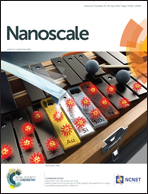Hafnia (HfO2) nanoparticles as an X-ray contrast agent and mid-infrared biosensor
Abstract
The interaction of hafnium oxide (HfO2) nanoparticles (NPs) with X-ray and mid-infrared radiation was investigated to assess the potential as a multifunctional diagnostic probe for X-ray computed tomography (CT) and/or mid-infrared biosensing. HfO2 NPs of controlled size were prepared by a sol–gel process and surface functionalized with polyvinylpyrrolidone, resulting in relatively spherical and monodispersed NPs with a tunable mean diameter in the range of ∼7–31 nm. The X-ray attenuation of HfO2 NPs was measured over 0.5–50 mM concentration and compared with Au NPs and iodine, which are the most prominent X-ray contrast agents currently used in research and clinical diagnostic imaging, respectively. At clinical CT tube potentials >80 kVp, HfO2 NPs exhibited superior or similar X-ray contrast compared to Au NPs, while both exhibited significantly greater X-ray contrast compared to iodine, due to the favorable location of the k-shell absorption edge for hafnium and gold. Moreover, energy-dependent differences in X-ray attenuation enabled simultaneous quantitative molecular imaging of each agent using photon-counting spectral (multi-energy) CT. HfO2 NPs also exhibited a strong mid-infrared absorption in the Reststrahlen band from ∼250–800 cm−1 and negative permittivity below 695 cm−1, which can enable development of mid-infrared biosensors and contrast agents, leveraging surface enhanced mid-infrared and/or phonon polariton absorption.


 Please wait while we load your content...
Please wait while we load your content...